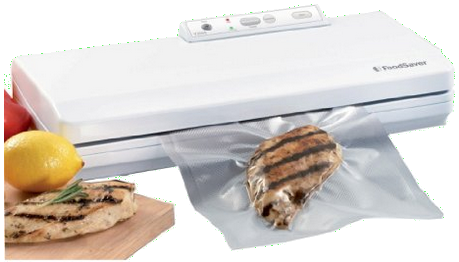
Please note that vacuum-packing increases the shelf-life of most if not all foods, these will taste better longer.
Only systems with electric pumps will come close to evacuating enough air and oxygen to be effective.
What vacuum-packing will not do is preserve food subject to microbiological invasion, like meat, dairy and fresh vegetables, against going bad. You must still take the same precautions like refrigeration.
Ambient moisture, sugar and acid content already in foods will continue to change them chemically and texturally making them unpalatable. This cannot be solved by vacuum-packing.
Any vacuum-packing system is only as good as the plastic bag or material. If this is compromised in manufacturing or as occasioned in storage and handling, the material may fail to be airtight.
There are some unexpected benefits to vacuum-packing you'll find in small situations such as repackaging brown sugar. Ordinarily, brown sugar will not keep because it dries out, becomes hard and cannot easily be used after that happens. Vacuum-packing solves that.
Here are some general benefits.
...in comparison with normal shelf life.
| Food | Stored in | Normal Shelf-life | Vacuum Shelf-life |
|---|---|---|---|
|
Large cuts of meat beef, poultry, lamb and pork |
Freezer | 6 months | 2-3 years |
|
Ground meat beef, poultry, lamb and pork |
Freezer | 4 months | 1 year |
| Fish | Freezer | 6 months | 2 years |
| Coffee beans | Room temperature | 4 weeks | 16 months |
| Coffee beans | Freezer | 6-9 months | 2-3 years |
|
Berries strawberries, raspberries, blackberries |
Refrigerator | 1-3 days | 1 week |
|
Berries cranberries, huckleberries, blueberries |
Refrigerator | 3-6 days | 2 weeks |
| Cheese | Refrigerator | 1-2 weeks | 4-8 months |
| Cookies, crackers | Room temperature (periodically opening) | 1-2 weeks | 3-6 weeks |
| Flour, sugar, rice | Room temperature | 6 months | 1-2 years |
| Lettuce | Refrigerator | 3-6 days | 2 weeks |
| Nuts | Room temperature | 6 months | 2 years |
|
Oils (with no preservatives) safflower, canola, corn oil |
Room temperature | 5-6 months | 1-1½ years |
| Wine | Refrigerator | 1-3 weeks | 2-4 months |